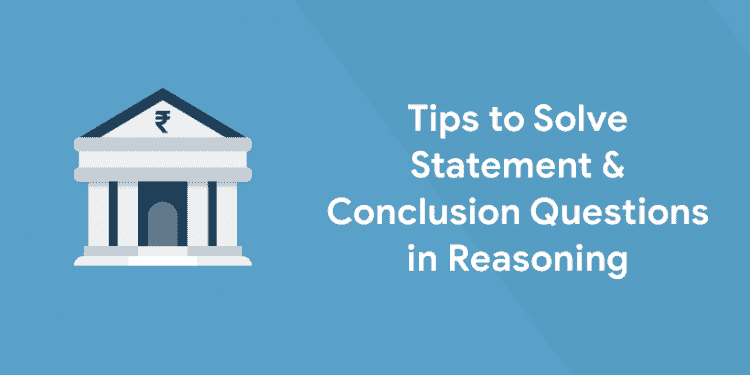Table of Contents
Statement and conclusion is a common topic in reasoning sections of most competitive exams. In this, a statement will be given followed by a set of conclusions. You need to choose the conclusion that logically follows the statement the most. Sometimes the conclusions can be directly understood by reading the statement and sometimes the aspirant needs to analyse it word for word to get the conclusion. Sometimes, only one conclusion may follow and sometimes both conclusions may follow. But, even so, there exists a chance of neither conclusion following. This is why we have prepared this article which gives you a few tips and tricks to solve Statement and Conclusion Questions in Reasoning.
Ace your preparation for competitive exams! Download App!
Types of Conclusions
In this segment, we will look into the different types of conclusions that can be reached while solving Statement & Conclusion Questions in reasoning. It is important to know this and be well versed to be able to solve the questions to the best of your ability.
Case 1
‘Only Conclusion 1 follows’: In these questions, only the first conclusion makes sense and is line with the statement.
For Example:
Statement: In a recent survey report, it has been stated that those who undertake physical exercise for at least half an hour a day are less prone to have any heart ailments.
Conclusions:
- Moderate level of physical exercise is necessary for leading a healthy life.
- All people who do desk-bound jobs definitely suffer from heart ailments.
In this Example, only conclusion 1 follows.
Case 2
‘Only Conclusion 2 follows’: In these questions, only the second conclusion makes sense and is in line with the statement.
For Example:
Statements: The national norm is 100 beds per thousand populations but in this state, 150 beds per thousand are available in the hospitals.
Conclusions:
- Our national norm is appropriate.
- The state’s health system is taking adequate care in this regard.
In this Example, only conclusion 2 follows.
Case 3
‘Either Conclusion 1 or 2 follows’: In these questions, both conclusions make sense and follow but if 1 follows then 2 cannot and if 2 follows, then 1 cannot. So the answer to be selected should be either 1 or 2 follow. Check out the example to understand better.
For Example:
Statement: A Corporate General Manager asked four managers to either submit their resignations by the next day or face termination orders from service. Three of them had submitted their resignations by that evening.
Conclusions:
- The next day, the remaining manager would also resign.
- The General Manager would terminate his services the next day.
In this example, both conclusions make sense, but if conclusion 1 occurs, then conclusion 2 cannot occur. If the remaining manager resigns, then the general manager cannot terminate his services the next day since he already resigned. On the other hand, if conclusion 2 occurred, then conclusion 1 couldn’t have occurred. If the General Manager terminates his services the next day, then that means the remaining manager hadn’t resigned.
We hope it is very clear now. Read on to find out tips to solve Statement and Conclusion Questions in Reasoning. The next segment will provide this.
Get Free Mock Tests for competitive exam! Download App!
Case 4
‘Neither Conclusion 1 nor 2 follow’: In these questions, both conclusions don’t make sense and aren’t in line with the statement given.
For Example:
Statement: The manager humiliated Sachin in the presence of his colleagues.
Conclusions:
- The manager did not like Sachin.
- Sachin was not popular with his colleagues.
In this, neither conclusion follows.
Case 5
‘Both Conclusion 1 and 2 follow’: In these questions, both conclusions make sense and are in line with each other. Either conclusion can occur while the other conclusion occurs and that is how it’s different from Case 3.
For Example:
Statement: A bird in hand is worth two in the bush.
Conclusions:
- We should be content with what we have.
- We should not crave for what is not.
In this, both conclusions follow.
Tips for Statement & Conclusion Questions
In this segment, we are going to provide you a few tips and tricks to help you solve Statement & Conclusion Questions in reasoning. Read on to find out and try your best to implement them in your preparations.
Do not Make any Assumptions
It is of utmost importance that you do not make any assumptions. The statement given in the question may defy logic or not make any sense but you must forget all that and base your conclusion on the statement given. They could say ‘The Earth is Flat’ and even though it’s not, for the sake of the question, you must believe it to be so. Don’t reach your own conclusions. Analyse and try to reach the same conclusion you would if you didn’t have prior knowledge about the subject matter of the statement.
Draw out the Circumstance
A lot of the times, the question can be such that you will need to imagine it to draw out a conclusion. It is very helpful to draw whatever is happening in the statement. It is very helpful to draw Venn Diagrams for questions like ‘All cats are dogs; some dogs are rats’. This may seem very confusing at first but writing it down or drawing it using a Venn diagram can help you reach a conclusion.
Get Weekly Current Affairs on the Entri App
Look for Keywords
The statement is very often created by using a couple of keywords and the rest of the sentence is completed with filler words. But it is important to know that the keywords are what the conclusions are based on. So, identifying and finding the keywords can help you find out the correct conclusion. The keywords will stick out and maybe even used more than once. Keep your eyes focused.
Watch out for Certain Trap Words
There are certain trap words that can either make a conclusion true or false. It rests within it the actual conclusion. These words are called trap words because aspirants often ignore them for common filler words but end up selecting the wrong option. That could’ve been avoided had they given attention to the trap word. Some common trap words include: Should, could, shall, will, either, neither, both, any, all, only, can be, shall be, will be, etc. Look out for them and know their functions. You will only be able to grasp their impact with continuous practice.
Don’t Stop Practicing
This is a very important topic in the reasoning section of most competitive exams especially common in bank exams. If you keep on practicing, you’ll start to notice methods of solving them and maybe even come up with a brand, new original method. Also, practicing can help you pick up on trap words and help you learn to navigate through them. But all this can only be achieved through practice. You can download the Entri App to get tons of quizzes, mock tests and questions to help you solve these types of questions and much more. Click here to see how attempting mock tests can improve your score.
Conclusion
This article was to help you by providing tips and tricks to help solve Statement and Conclusion Questions in reasoning. Understanding and Implementing these tips in your preparations can make a considerable difference that you will be able to see in your increasing marks. But, the most important aspect is constant practice either through questions, mock tests or quizzes. To avail all these things, download the Entri App and get access not only to these but also to Online Classes and Video Lectures. This is a very good time to focus and prepare. Good Luck.













